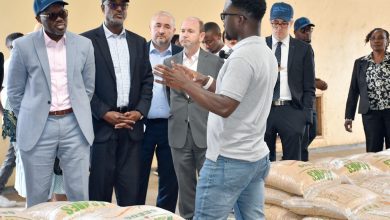Patients’ lives at risk over drug scarcity, funding
Daniel Phiri winces as he slowly rolls down his trousers to reveal a deep gash on his shin—the result of a fall from his bicycle three weeks ago.
The wound is red, swollen and oozing pus, a sign that infection is setting in.

“I went to the health centre twice, but they told me there were no antibiotics,” says Phiri, 43, a farmer from Dowa.
“They told me to buy from a pharmacy in town. But I don’t have the money.”
Without treatment, Phiri risks severe infection, sepsis and permanent disability.
His story is not unique. Across Malawi, patients with urgent conditions—from infected wounds to chronic illnesses such as HIV—are falling through the cracks of an under-resourced health system battling chronic shortages of essential medicines.
At Queen Elizabeth Central Hospital in Blantyre, Lydia Samson, 33, says she was told to either pay K5 000 for her three-year-old son’s psoriasis treatment or go to nearby Gateway Clinic where the drugs might be free.
“I had to borrow money. If I waited, his condition would have gotten worse,” she says.
And Grace Jere, a trader at Mbayani market in the city, refuses to visit the clinic for the itchy rash spreading across her arms and back.
“What’s the point?” she shrugs. “I’ll just waste money on transport and come back without medicine.”
Network of Journalists Living with HIV (Joneha) executive director David Kamkwamba warns that the consequences are serious.
“For people with HIV, diabetes, hypertension or bacterial infections, missing treatment can mean complications, hospitalisation or even death. Some patients default on treatment simply because the drugs aren’t there,” he says.
Joneha has been monitoring medicine availability in Mulanje and Phalombe districts, noting consistent stock-outs of key drugs.
Between October and December 2024, shortages included Cotrimoxazole (CPT 960), Paracetamol, Ciprofloxacin, Aminophylline, Hydrochlorothiazide (HCTZ), Salbutamol, and Phenobarbital..
Cotrimoxazole is critical for people living with HIV to prevent opportunistic infections and its absence can quickly lead to life-threatening illness.
“These gaps are not just about money,” Kamkwamba explains. “We’ve also documented systemic problems from delayed deliveries to parallel supply chains and poor forecasting that worsen shortages even when some funds are available.”
Central Medical Stores Trust (CMST), which procures, warehouses and distributes medicines to public facilities, says it is delivering within available resources.
CMST chief executive officer Chikaiko Chadzunda said they spent K55.5 billion on essential medicines list against a budget of K30.9 billion in 2023/24.
However, while the average availability of medicines on the CMST’s must-have list is 72 percent; hospitals sometimes receive only 60 percent of what they request.
According to Ministry of Finance budget officer Maha Kamwendo, the mismatch stems from competing priorities and limited fiscal space.
“The budget process allocates funds based on the ceiling provided by Treasury,” he told a stakeholders’ meeting on delayed and inadequate disbursement of funding to district hospitals in Mponela, Dowa last Tuesday.
“If procurement needs exceed that ceiling, it creates gaps.”
Health authorities acknowledge the strain, but insist efforts are underway to improve procurement efficiency.
They cite ongoing reforms in supply chain management and the establishment of pooled procurement systems meant to reduce delays.
Still, Joneha monitoring and evaluation officer Tracy Mwalilino argued that shortages reflect deeper structural problems.
“We are dependent on donor support and when funds delay, procurement stalls. In the end, it is innocent patients who pay the price.”
Malawi’s drug budget remains significantly below World Health Organisation (WHO) recommended levels, both in per capita health spending and in the proportion of health sector funding devoted to medicines.
The Ministry of Health’s drug quantification shows a K75 billion shortfall, threatening consistent availability of life-saving medicines, including antiretroviral therapy and preventive drugs for HIV-positive patients.
To reach WHO’s benchmark of $86 per person, Malawi would need to increase public health funding by more than fivefold; a distant target under current fiscal constraints.
Observations confirm identical trends across district health offices nationwide – erratic deliveries, overburdened referral hospitals and patients increasingly pushed to private pharmacies where prices are out of reach for most.
Kamkwamba says timely release of funds and data-driven planning could avert many shortages.
“We need to set drug budgets based on actual consumption data, not outdated estimates,” he says.
Chadzunda agrees that better forecasting is part of the solution, but stresses that funding must also be predictable.
“We can only deliver what has been procured and procurement depends entirely on the funds available.”
Mwalilino notes that community monitoring empowers communities.
“When people know what medicines should be available at their clinic, they can demand answers when they are missing,” she says.
For patients such as Phiri, the solutions being discussed at policy level cannot come soon enough.
His wound, untreated for weeks, has already begun to limit his movement.
“I just want to get back to work,” he says quietly. “But without medicine, I can’t heal.”
The stories from Phiri, Samson and Jere, as well as the missing HIV-preventive drugs in Joneha’s records, are snapshots of a national challenge. Without both financial and systemic reforms, Malawi’s promise of universal health coverage risks becoming little more than words on paper.





